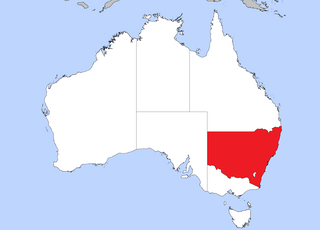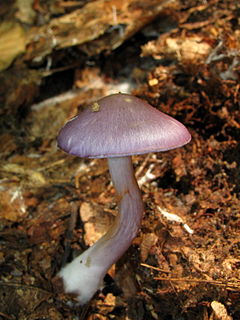
Cortinarius mucosus, commonly known as the orange webcap or the slimy cortinarius, is a species of mushroom in the family Cortinariaceae. In North America, the species is more commonly associated with northern coniferous forests. The specific epithet is derived from the Latin word mucosus, meaning mucus.

Cortinarius rotundisporus, also known as the elegant blue webcap, is a basidiomycete mushroom of the genus Cortinarius found in southern Australia, where it is found in eucalypt forests and rainforests. The cap of the fruit body is a steely blue colour, with a yellowish boss, and paler similarly coloured stipe.

Cortinarius violaceus, commonly known as the violet webcap or violet cort, is a fungus in the webcap genus Cortinarius native across the Northern Hemisphere. The fruit bodies are dark purple mushrooms with caps up to 15 cm (6 in) across, sporting gills underneath. The stalk measures 6 to 12 centimetres by 1 to 2 centimetres, sometimes with a thicker base. The dark flesh has a smell reminiscent of cedar wood. Forming symbiotic (ectomycorrhizal) relationships with the roots of various plant species, C. violaceus is found predominantly in conifer forests in North America and deciduous forests in Europe.

Cortinarius archeri is a species of mushroom in the genus Cortinarius native to Australia. The distinctive mushrooms have bright purple caps that glisten with slime, and appear in autumn in eucalypt forests.

Cortinarius traganus, also known as the gassy webcap, is a basidiomycete mushroom of the genus Cortinarius. The mushrooms are characterized by their lilac color, the rusty-brown gills and spores, and rusty-brown flesh in the stem.

Cortinarius anomalus, also known as the variable webcap, is a basidiomycete fungus of the genus Cortinarius. It produces a medium-sized mushroom with a grayish-brown cap up to 5 cm (2.0 in) wide, gray-violet gills and a whitish stem with pale yellow belts below. The mushroom grows solitarily or in scattered groups on the ground in deciduous and coniferous forests. It is found throughout the temperate zone of the northern hemisphere.

Cortinarius vanduzerensis is a species of mushroom in the family Cortinariaceae. Described as new to science in 1972, it is known only from the Pacific Northwest region of North America, where it grows under conifers such as spruce, hemlock, and Douglas-fir. The fruit bodies of the fungus, or mushrooms, have a slimy dark chestnut-brown cap that becomes deeply radially grooved or corrugated in maturity, and reaches diameters of up to 8 cm (3.1 in). The gills on the underside of the cap are initially pinkish-buff before becoming pale brown when the spores mature. The stem is lavender, measuring 10–18 cm (3.9–7.1 in) long and 1–2 cm (0.4–0.8 in) thick. The mushroom produces a rusty-brown spore print, with individual spores measuring 12–14 by 7–8 micrometers. The edibility of the mushroom has not been determined, and it has been described as "much too slippery to be of value".
Cortinarius badiolaevis is a fungus in the family Cortinariaceae. The species produces mushrooms with smooth, red-brown caps up to 5 centimetres (2.0 in) in diameter, after which it is named. It has a white stem, and yellow-brown gills. It was first described in 2011, based on specimens collected in the 1990s and 2000s. C. badiolaevis is part of the subgenus Telamonia, but is not part of any known section, and does not have any close relatives within the genus. The rare species is known from Sweden and Spain, where it grows from soil in coniferous woodland.

Cortinarius camphoratus, commonly known as the goatcheese webcap, is an agaric fungus in the family Cortinariaceae. The fungus is found in Europe and North America, where its fruit bodies (mushrooms) grow on the ground in a mycorrhizal association with spruce and firs in coniferous forests. Mushrooms are characterized by pale blue lilac colors when young, and a strong distinctive odor. Sources disagree as to the edibility of the mushroom, but they are generally not recommended for eating.

Cortinarius argyrionus is a species of sequestrate (truffle-like) fungus in the family Cortinariaceae. Described as a new species in 2010, it is known only from New South Wales.

Cortinarius caesibulga is a species of truffle-like fungus in the family Cortinariaceae. Found in New South Wales, Australia, the species was described as new to science in 2010.

Cortinarius maculobulga is a species of truffle-like fungus in the family Cortinariaceae. Found only in New South Wales, Australia, it was described as new to science in 2010.

Cortinarius iodes, commonly known as the spotted cort or the viscid violet cort, is a species of agaric fungus in the family Cortinariaceae. The fruit bodies have small, slimy, purple caps up to 6 cm (2.4 in) in diameter that develop yellowish spots and streaks in maturity. The gill color changes from violet to rusty or grayish brown as the mushroom matures. The species range includes the eastern North America, Central America, northern South America, and northern Asia, where it grows on the ground in a mycorrhizal association with deciduous trees. The mushroom is not recommended for consumption. Cortinarius iodeoides, one of several potential lookalike species, can be distinguished from C. iodes by its bitter-tasting cap cuticle.

Tricholoma vernaticum is an agaric fungus of the genus Tricholoma native to the Pacific Northwest region of the United States. The fungus was originally described in 1976 as a species of Armillaria when that genus was more inclusive; it received its current name twenty years later. The stout fruit bodies (mushrooms) have moist white to grayish caps, a membranous ring on the stipe, and an odor resembling cucumbers. Mycorrhizal with conifers, the fungus fruits in the spring or early summer, with its mushrooms appearing on the ground singly or in groups at high elevations, often at the edge of melting snowbanks. The edibility of the mushroom is unknown, but it has a strong unpleasant odor and a mealy taste.

Cortinarius australiensis, commonly known as the skirt webcap, is a species of mushroom in the genus Cortinarius native to Australia and New Zealand. The white mushrooms appear in autumn and can grow very large, with their caps reaching 30 cm (12 in) in diameter.
Cortinarius boreicyanites is a species of fungus in the large mushroom genus Cortinarius. Found in the boreal mixed forests of Europe, it was described as new to science in 2014. Its fruitbodies have hemispherical to convex caps measuring 4–10 cm (1.6–3.9 in) in diameter. Initially bluish gray, the cap colour matures to pale grayish brown. Gills on the cap underside have an emarginate attachment to the stipe. They start out greyish blue before changing to brownish violet when the spores mature. The club-shaped to bulbous stipe measures 5–10 cm (2.0–3.9 in) long, and up to 4 cm (1.6 in) wide at the base.

Cortinarius erythraeus is a basidiomycete fungus of the genus Cortinarius native to Australia.

Cortinarius cyanites is a basidiomycete fungus of the genus Cortinarius native to Europe.
Cortinarius cucumeris is a basidiomycete fungus of the genus Cortinarius native to New Zealand, where it grows under Nothofagus.
Cortinarius jenolanensis is a fungus native to Australia. It was described in 2009 by Alec Wood, from a specimen collected at the Jenolan Caves on 30 April 1988. It has also been recorded from Tidbinbilla Nature Reserve in the Australian Capital Territory.














